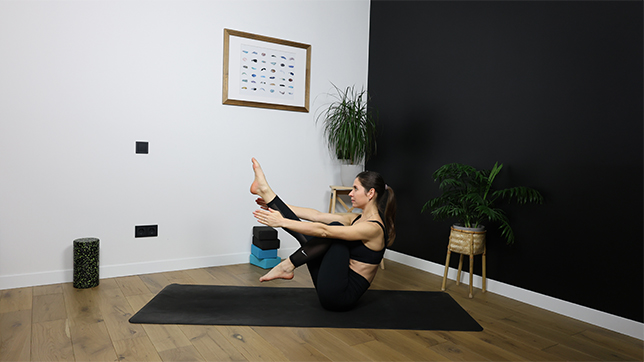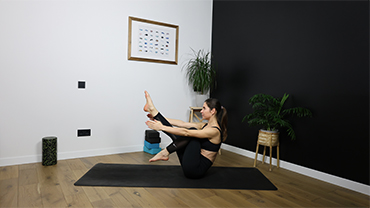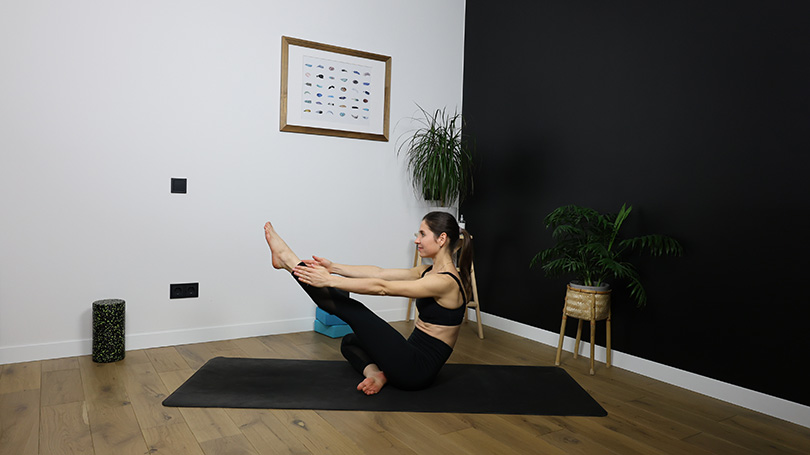One Legged Half Boat Pose - Eka Pada Navasana

Contents
One Legged Half Boat Pose or Eka Pada Navasana is a basic seated asana that strengthens the abdominal muscles. The name comes from the Sanskrit, eka, meaning “one”; pada, meaning “foot” or “leg”; nava, meaning “boat”; and asana, meaning “pose” or “posture.”
In addition to building core strength, the eka pada variation is believed to improve focus and concentration.
One Legged Half Boat Pose helps strengthen the abdominal, core body strength, and legs.
Pose Detail
- By Type: Balancing Yoga Poses, Strengthening Yoga Poses
- Difficulty: Intermediate
- Body Position: Seated Yoga Poses
- By Benefit: Yoga Poses For Digestion, Yoga Poses For Stress Relief
Step-by-Step Instructions
Benefits and Contraindications
Improves digestion
Burns belly fat
Strengthens the core muscles
Improves balance
Enhances blood circulation
Stress buster
Pregnancy or menstruation
Diarrhea
Neck, back, hip, knee, or ankle injury
Asthma
Insomnia
Photo poses in different angles

Modifications and Props for Beginners
- Instead of straightening your extended leg, bend your knee and place the foot on the ground. This will help you to maintain your balance and engage your core more effectively.
- If you have difficulty reaching your foot with your hands, use a strap to loop around the arch of your foot. Hold the strap with both hands and use it to pull your foot towards your chest as you lift your torso.
- If you have difficulty balancing, practice the pose with your back against a wall. Sit on the floor with your back against the wall and your feet on the ground. Lift your feet off the ground and straighten one leg, pressing the heel into the wall for support.
Useful Tips
- Focus on engaging your abdominal muscles and drawing your navel towards your spine to help support your lower back.
- As you lift your torso and extend your leg, try to keep your chest lifted and open. Avoid collapsing your chest or rounding your spine, which can put pressure on your lower back.
- Imagine lengthening your spine from the crown of your head to your tailbone. This will help you to maintain good posture and balance in the pose.
- Try to keep your shoulders relaxed and away from your ears. Avoid tensing up or shrugging your shoulders, which can create tension in your upper back and neck.
One Legged Half Boat Pose Variation
The Supported One-Legged Boat Pose is a variation of Navasana (Boat Pose) in yoga. This variation adds an element of support for the back to help maintain proper alignment and make the pose accessible for individuals with lower back sensitivity.

Benefits:
- Engages and strengthens the core muscles.
- The prop under the lower back provides support, making it suitable for individuals with lower back sensitivity.
- Challenges and improves balance and concentration.
Frequently Asked Questions
One Legged Half Boat Pose can be challenging for beginners, especially those who lack core strength and balance. It’s important to work with a qualified yoga teacher who can provide modifications and guide you through the pose safely.
If you have a back injury, it’s important to consult with your doctor or physical therapist before practicing One Legged Half Boat Pose. Depending on the nature and severity of your injury, you may need to avoid or modify the pose.
You can modify One Legged Half Boat Pose by bending the knee of the extended leg, using a strap or block for support, or practicing the pose with your back against a wall.
To deepen One Legged Half Boat Pose, you can work on lifting your torso and leg higher, straightening your extended leg, and holding the pose for longer periods of time. You can also try practicing the pose with your arms extended overhead or by moving into the full Boat Pose variation.
Variations
- Half Boat Pose
- Supported One Legged Boat Pose
- Complete Boat Pose
- Elevated Boat Pose